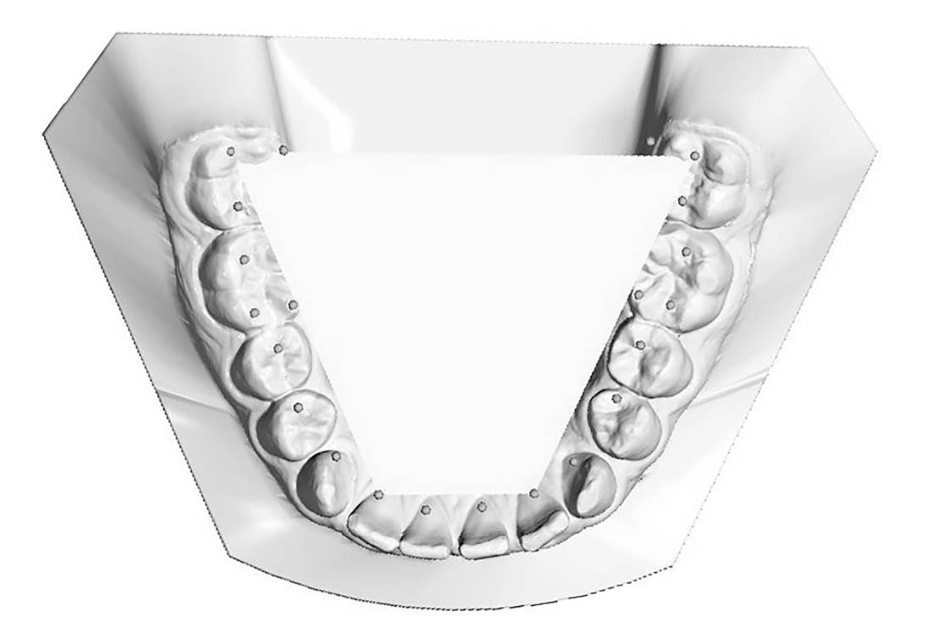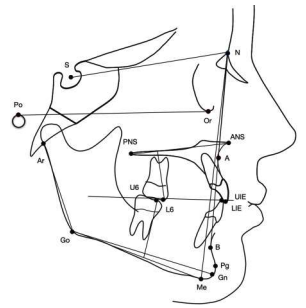Roberta Lione, Alessia Balboni, Valentina Di Fazio, Chiara Pavoni1 and Paola Cozza
Abstract
Background: The aim of the present study was to compare the effects on vertical dentoskeletal dimension pro- duced by Pendulum appliance and Clear Aligners in patients with Class II malocclusion.
Trial design: This is a prospective two-arm parallel group randomized clinical trial with 1:1 allocation ratio.
Methods: The Pendulum Group (PG) consisted of 20 patients (15F, 5 M) with a mean age of 17.2 ± 4.3 years. The Clear Aligners Group (CAG) comprised 20 patients (13F, 7 M) with a mean age of 17.2 ± 3.2 years. Distalization’s protocol in PG involved the activation of TMA wires till the achievement of Class I molar relationship. A protocol of sequential distalization was applied in the CAG. For each subject lateral cephalograms have been analyzed before treatment (T1) and at the end of the therapy (T2). Descriptive statistics and statistical between-group comparisons (PG vs CAG) were calculated for the craniofacial starting forms at T1 and for the T2–T1 changes. Statistical between-group comparisons for the T2–T1 changes were performed with independent samples t-tests (P < 0.05).
Results: The PG showed significantly greater increases in SN^GoGn° when compared with CAG (+ 2.1 and − 0.3 degrees, respectively). Clockwise rotation of the occlusal plane with significantly greater increase of SN^POccl angle was observed in PG (+ 2.8 degrees) when compared with CAG (− 4.2 degrees). The PG revealed a significant increase in the N-Me variable with a mean change of + 4.4 mm compared to the CAG with mean values of − 1.2 mm. The PG showed an increase in the ArGo^GoMe angle (+ 0.7° degrees) compared to the CAG (− 3.4° degrees). The PG showed significantly greater increases in both maxillary and mandibular first molar to palatal plane (+ 1.3 and + 2.1 mm, respectively) when compared with CAG (− 0.9 and − 0.2 mm, respectively).
Conclusions: Upper molar distalization with clear aligners represents a valid alternative to non-extraction treat- ment of Class II malocclusion, reducing the extrusion of maxillary first molars and improving the management of the occlusal plane and vertical dimension.
Trial registration: ClinicalTrials.gov, NCT05298280. Registered 28 March 2022—Retrospectively registered, https://clini caltrials.gov.
Keywords: Class II, Distalization, Pendulum, Clear aligners
Background
Treatment of Class II malocclusion is one of the most investigated and controversial issues in contemporary orthodontics because of the extensive variability of treat- ment protocols addressing the morphological charac- teristics of it [1, 2]. Maxillary molar distalization is one of the most common strategies to correct Class II molar relationship and it is commonly indicated for patients with maxillary dentoalveolar protrusion or minor skeletal discrepancies [3, 4]. In 1992 Hilgers introduced the Pen- dulum appliance that has shown great results in terms of molars distalization. However, many side effects such as labial/mesial tipping and protrusion of the maxillary incisors and premolars, distal tipping of the maxillary molars, increase in lower anterior face height, clockwise mandibular rotation and extrusion of the first premolars have been reported [5–11]. During the following phase with fixed appliance the side-effects have to be corrected [5–9].
In the last decades, the orthodontic treatment with removable clear aligners has become an increasing com- mon choice because of the growing number of adult patients who ask for aesthetic and comfortable alterna- tives to conventional fixed appliances [12–14]. Only few investigations have focused on the predict- ability of orthodontic tooth movement with clear align- ers (CAT) [15–17]. A systematic review by Rossini et al. pointed out that among the dental movements analyzed in 11 studies, the bodily distalization was the most pre- dictable [17].
According to Simon et al. aligners allow a high accu- racy (88%) of the bodily movement of upper molars when a mean distalization movement of 2.7 mm was required, especially when the movement was assisted by the use of attachments [18, 19]. As reported by Ravera et al. maxillary distalization without mesiodistal tipping movements and lower facial height changes can be achieved with clear aligners. Con- sequently, the use of aligners is recommended when 2 to 3 mm of maxillary molar distalization are needed in non- growing subjects [14].
However, a detailed analysis of the skeletal and dental changes produced by pendulum appliance and by clear aligners in Class II treatment is still lacking. The hypoth- esis underlying this investigation is that the presence of plastic coverage on posterior upper and lower teeth pro- vided by clear aligners allows for a better control of side effects on vertical dimension. Therefore, the aim of the present randomized prospec- tive clinical study was to compare the effects on vertical dimension determined by maxillary molar distalization with pendulum versus clear aligners at the end of com- prehensive treatment.
Methods
Study design
The Consolidated Standards of Reporting Trials (CON- SORT) checklist was used as a guideline for conducting and reporting this trial. The present RCT was designed as a prospective two-arm parallel group randomized clinical trial with 1:1 allocation ratio. The study was car- ried out in accordance with the Declaration of Helsinki and the proposal was approved by the Ethics Committee at the University of XXXX (protocol number 257/21). After a full explanation of the nature, purpose, and mate- rial risks of the proposed procedures, informed consent was obtained from patients or from patients’ parents for juvenile subjects. The patients were aware that they could have received a different treatment method accord- ing to a randomized allocation sequence. The trial was registered on ClinicalTrials.gov (registration number: NCT05298280).
Population
All subjects were selected according to the following inclusion criteria: permanent dentition with upper and lower second molars fully erupted, bilateral Class II or end to end Class II molar relationship (up to 3 mm of molar relationship discrepancy), skeletal Class I or mild Class II malocclusion (ANB angle between 2 and 7°), normodivergence on the vertical plane (SN^GoGn com- prised between 32 and 37 degrees), crowding in the lower arch (≤6 mm). All patients were in good general health with healthy periodontium, generalized probing depths not exceeding 3 mm, and no radiographic evidence of periodontal bone loss. The exclusion criteria were: patients who required functional appliance therapy, those who had previous orthodontic treatment or extraction including extraction of upper third molars, hypodontia, craniofacial syndromes or cleft, previous prosthodontic treatments of the upper molars.
Treatment
Subjects enrolled in the study were randomly assigned to two groups: Pendulum Group (PG) and Clear Aligner Group (CAG). All subjects were treated by the same cli- nician (RL).
Pendulum group (PG)
In the PG, all patients received a pendulum appliance as described by Angelieri et al. [20]. The Nance button was anchored to the first and second premolars with remov- able wires. The 0.032-inch TMA wires were activated 45 degrees to produce a force of 200–250 g per side. On aver- age, intraoral reactivation of the distalizing springs was performed twice during the procedure. As recommended by Byloff et al., an uprighting bend was added to the end of TMA wire to prevent excessive molar tipping. When a super Class I molar relationship was obtained, pendu- lum was replaced by a Nance holding arch. The average treatment duration was 6 months followed by full fixed conventional 0.022-in slot pre-adjusted edgewise brack- ets (McLaughlin–Bennett–Trevisi prescription) on all teeth including upper and lower second molars. Standard continuous archwire sequence during alignment and lev- elling phases (0.016-in round, 0.019×0.025-in rectangu- lar, nickel–titanium alloys and 0.019×0.025 in stainless steel) was used in all subjects. Alignment and levelling were considered finished when passive engagement of a 0.019 × 0.025-in stainless steel archwire was obtained. All subjects were treated with Class II intermaxillary elastics (1/4 in., 6.5 oz) after the achievement of Class I molar relationship to support anchorage in addition to Nance button during the retraction of upper premolars, canines and incisors. The patients were instructed to wear Class II elastics for at least 16 h per day. The Class II elastics were dismissed at the end of the working phase. The mean treatment time was 20 ± 2 months (Fig. 1).
Clear aligner group (CAG)
The treatment of sequential upper arch distalization was performed by the same board-certified orthodontists as proposed by Align Technology and described by Ravera et al. [14]…


